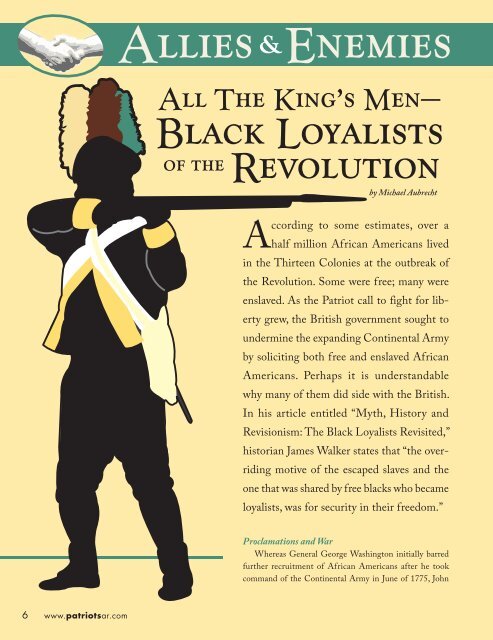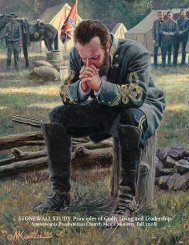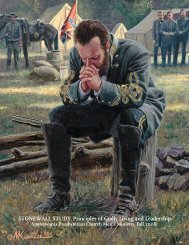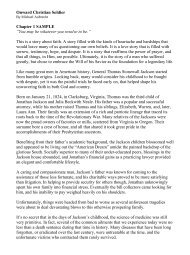PAR: Black Loyalists - Pinstripe Press by Michael Aubrecht
PAR: Black Loyalists - Pinstripe Press by Michael Aubrecht
PAR: Black Loyalists - Pinstripe Press by Michael Aubrecht
Create successful ePaper yourself
Turn your PDF publications into a flip-book with our unique Google optimized e-Paper software.
Allies & Enemies<br />
All The King’s Men—<br />
<strong>Black</strong> <strong>Loyalists</strong><br />
of the Revolution<br />
<strong>by</strong> <strong>Michael</strong> <strong>Aubrecht</strong><br />
According to some estimates, over a<br />
half million African Americans lived<br />
in the Thirteen Colonies at the outbreak of<br />
the Revolution. Some were free; many were<br />
enslaved. As the Patriot call to fight for liberty<br />
grew, the British government sought to<br />
undermine the expanding Continental Army<br />
<strong>by</strong> soliciting both free and enslaved African<br />
Americans. Perhaps it is understandable<br />
why many of them did side with the British.<br />
In his article entitled “Myth, History and<br />
Revisionism: The <strong>Black</strong> <strong>Loyalists</strong> Revisited,”<br />
historian James Walker states that “the overriding<br />
motive of the escaped slaves and the<br />
one that was shared <strong>by</strong> free blacks who became<br />
loyalists, was for security in their freedom.”<br />
Proclamations and War<br />
Whereas General George Washington initially barred<br />
further recruitment of African Americans after he took<br />
command of the Continental Army in June of 1775, John<br />
6 www.patriotsar.com
Murray—the 4th Earl of Dunmore and Royal Governor<br />
of Virginia—formally called on slaves in Virginia to side<br />
with the British that November.<br />
His proclamation stated:<br />
“And I here<strong>by</strong> further declare all indented servants,<br />
Negroes, or others, (appertaining to Rebels,)<br />
free that are able and willing to bear arms, they<br />
joining His Majesty’s Troops as soon as may be,<br />
for the more speedily reducing this Colony to a<br />
proper sense of their duty, to this Majesty’s crown<br />
and dignity.”<br />
Governor Dunmore was keenly aware of this offer’s<br />
effect. Not only would extra manpower help bolster and<br />
support the British troops in Virginia (at this point cut off<br />
from reserves in Boston), but the arming of slaves terrified<br />
many colonists. Planters abandoned their military posts<br />
to protect their families and property from the threat of a<br />
slave insurrection.<br />
In response to Dunmore’s decree, the Representatives<br />
of the People of the Colony and Dominion of Virginia<br />
issued their own counter-proclamation in December<br />
of 1775:<br />
“WHEREAS Lord Dunmore, <strong>by</strong> his proclamation,<br />
dated on-board the ship William, off Norfolk,<br />
the 7th day of November 1775, hath offered freedom<br />
to such able-bodied slaves as are willing to<br />
join him, and take up arms, against the good people<br />
of this colony, giving there<strong>by</strong> encouragement to<br />
a general insurrection, which may induce a necessity<br />
of inflicting the severest punishments upon<br />
those unhappy people, already deluded <strong>by</strong> his base<br />
and insidious arts; and whereas, <strong>by</strong> an act of the<br />
General Assembly now in force in this colony, it is<br />
enacted, that all Negro or other slaves, conspiring<br />
to rebel or make insurrection, shall suffer death,<br />
and be excluded all benef it of clergy: We think it<br />
John Murray, the 4th Earl of Dunmore<br />
and Royal Governor of Virginia<br />
Sir Joshua Reynolds<br />
A scan of Dunmore’s 1775 proclamation<br />
Library of Congress, Rare Book and<br />
Special Collections Division<br />
7
Soldiers in the Ethiopian Regiment were<br />
outfitted in exceptionally striking uniforms<br />
embroidered with the phrase “Liberty to Slaves.”<br />
proper to declare, that all slaves who have been,<br />
or shall be seduced, <strong>by</strong> his lordship’s proclamation,<br />
or other arts, to desert their masters’ service, and<br />
take up arms against the inhabitants of this colony,<br />
shall be liable to such punishment as shall hereafter<br />
be directed <strong>by</strong> the General Convention. And to<br />
that end all such, who have taken this unlawful<br />
and wicked step, may return in safety to their duty,<br />
and escape the punishment due to their crimes, we<br />
here<strong>by</strong> promise pardon to them, they surrendering<br />
themselves…and not appearing in arms after the<br />
publication hereof. And we do farther earnestly recommend<br />
it to all humane and benevolent persons<br />
in this colony to explain and make known this our<br />
offer of mercy to those unfortunate people.”<br />
Patriot newspapers voiced paranoia and called for citizens<br />
to practice vigilance and increase security; restrictions<br />
on slave privileges, such as meeting in groups or conducting<br />
worship services, were immediately tightened. The Virginia<br />
Gazette published a stern warning to all slaves, stating:<br />
“Be not then…tempted <strong>by</strong> the proclamation to ruin your<br />
selves.” The publication also called Lord Dunmore a hypocrite,<br />
being a slaveholder himself, and ordered all servants<br />
to “cling to their masters.”<br />
These responses did little to prevent approximately<br />
300 slaves from joining Dunmore’s “Ethiopian Regiment”<br />
<strong>by</strong> December of 1775. They were outfitted in exceptionally<br />
striking uniforms embroidered with the phrase<br />
“Liberty to Slaves.” In all, it is estimated that close to<br />
800 men eventually joined the regiment, which did see<br />
some military action in Virginia at the battles of Kemp’s<br />
Landing and Great Bridge before smallpox took a deadly<br />
toll on the soldiers.<br />
The Ethiopian Regiment was disbanded in 1776.<br />
Three years later, British General Henry Clinton issued<br />
the Philipsburg Proclamation, which granted<br />
“every negro who shall desert the rebel standard<br />
full security to follow within these lines any occupation<br />
which he shall think proper.”<br />
This declaration, which was directed towards all slaves<br />
in the United States, instigated a resurgence of enlistees,<br />
many of whom were ironically put to work on captured<br />
plantations to grow food for the British Army.<br />
Regardless of whether they had been free or previously<br />
enslaved, black <strong>Loyalists</strong> fought with great courage and<br />
determination. One who certainly stood out was known as<br />
Colonel Tye. This former slave from Monmouth County,<br />
New Jersey, had served in the Ethiopian Regiment and<br />
fought for the British at the Battle of Monmouth. More<br />
notable, though, was the fact that he led a group of white<br />
and African American guerrillas in his home state and<br />
New York for most of 1779-1780, during which he and<br />
his men stole livestock, freed slaves, and captured and executed<br />
Patriots. In September of 1780, Tye was wounded<br />
while attempting to capture a Continental Army captain,<br />
and later died of infection.<br />
Of course, the Loyalist cause itself would eventually die.<br />
Life After Defeat<br />
In 1782, many black <strong>Loyalists</strong> fled to one of the last<br />
British strongholds in the United States: New York City.<br />
Once a provisional treaty was signed <strong>by</strong> Great Britain<br />
and the United States in November of that year, General<br />
Washington—under orders from Congress—demanded<br />
that before the British evacuated the city, they had to return<br />
all slaves who had been owned <strong>by</strong> Americans.<br />
8 www.patriotsar.com
The Freetown Colony in the 19 th century<br />
John Leighton Wilson<br />
A black Loyalist and former slave named Boston King<br />
later summarized his feelings at learning of this information:<br />
“…the horrors and devastation of war happily<br />
terminated and peace was restored between<br />
America and Great Britain, which diffused universal<br />
joy among all parties; except us, who had<br />
escaped from slavery and taken refuge in the<br />
English army; for a report prevailed at New-York,<br />
that all the slaves, in number 2,000, were to be<br />
delivered up to their masters altho’ some of them<br />
had been three or four years among the English.<br />
This dreadful rumour f illed us all with inexpressible<br />
anguish and terror, especially when we saw our<br />
old masters coming from Virginia, North Carolina,<br />
and other parts, and seizing upon their slaves in<br />
the streets of New York, or even dragging them<br />
out of their beds. Many of the slaves had very cruel<br />
masters, so that the thoughts of returning home<br />
with them embittered life to us.”<br />
To Washington’s dismay, British General Guy Carleton<br />
insisted that both Dunmore’s and Clinton’s proclamations<br />
should be honored—that is, former slaves should be given<br />
“certificates of freedom” and allowed to leave New York<br />
City if they could prove that they had served with the<br />
British during the war. In the end, and after many meetings<br />
between Americans and a British review board, several<br />
thousand slaves were allowed to join free black and white<br />
<strong>Loyalists</strong> in departing New York City.<br />
A majority of these black <strong>Loyalists</strong> eventually settled in<br />
what are now Canada’s Maritime provinces—Nova Scotia,<br />
New Brunswick, and Prince Edward Island. As author<br />
Lloyd Do<strong>by</strong>ns states in his article entitled “Fighting…<br />
Maybe for Freedom, But Probably Not”:<br />
“The refugees landed in a cold, sparsely settled,<br />
forested place, populated <strong>by</strong> Scots, Protestants from<br />
France, Switzerland, and Germany, and a few of<br />
the Mi’kmaq tribesmen who were the original residents.<br />
In no time at all, it was clear that whatever<br />
9
the American blacks were called and whatever they<br />
had been promised, they would be treated like slaves<br />
and live a life not much better and a lot colder, than<br />
they had lived in the American colonies.”<br />
The black <strong>Loyalists</strong> had an exceptionally hard time obtaining<br />
land. According to the <strong>Black</strong> Loyalist Heritage Society:<br />
“The loyalist colonies were not equipped to<br />
maintain the influx of thousands of new citizens.<br />
A priority system was established to serve the newest<br />
citizens to British North America. White off icers<br />
and gentlemen were served f irst in terms of rations<br />
and land grants. Ordinary privates and laboring<br />
people, among the whites, had to wait. The blacks,<br />
coming up last, rarely received the land or rations<br />
promised to them.”<br />
A collection of petitions relating to land grants in New<br />
Brunswick, written between 1783 and 1854, can be found<br />
on the Atlantic Canada Virtual Archives. The Archives’<br />
Web site states that<br />
“Although one hundred African American families<br />
were eventually granted full allotments in Saint<br />
John [New Brunswick’s largest city], they soon discovered<br />
that their land was almost eighteen miles outside<br />
the town, making communication diff icult. Large<br />
tracts of land were surveyed for African American<br />
settlements on the Nerepis River and Milkish Creek,<br />
and St. Martins, but none of these areas was ideal for<br />
farming. Like many of the white loyalists, the African<br />
American population in New Brunswick often had<br />
little or no experience with clearing land, but many<br />
white families had the advantage of having at least<br />
brought some household goods and money with them.”<br />
Thus it is not surprising that over a thousand black<br />
<strong>Loyalists</strong> in Nova Scotia and New Brunswick—including<br />
the former slave Boston King—left for Britain’s new<br />
Freetown Colony in Sierra Leone in 1792. Yet despite their<br />
hardships, some of the black <strong>Loyalists</strong> who did remain in<br />
Canada fought for Britain again during the War of 1812.<br />
During this conflict, more escaped slaves migrated to<br />
Canada; they were referred to as “black refugees” to distinguish<br />
them from the black <strong>Loyalists</strong>.<br />
The story of the black <strong>Loyalists</strong> is both tragic and fascinating.<br />
Like many Americans, they too fought for freedom<br />
and liberty—their personal freedom, their personal liberty.<br />
Today, many proud descendants of these soldiers still<br />
reside in Canada and maintain the memory of their ancestors,<br />
even as the rest of the world seems to have forgotten<br />
the cause and struggle of the black Loyalist.<br />
References<br />
Atlantic Canada Virtual Archives, “Exploring the Lives of <strong>Black</strong> <strong>Loyalists</strong>.” http://<br />
atlanticportal.hil.unb.ca/acva/blackloyalists/en/<br />
Bell, David G. “Slavery and the Judges of Loyalist New Brunswick,” University New<br />
Brunswick Law Journal/Revue de droit de l’Université du Nouveau-Brunswick<br />
31 (1982).<br />
The <strong>Black</strong> Loyalist Heritage Society, “Loyalist History.”<br />
http://www.blackloyalist.com/<br />
Cahill, Barry. “The <strong>Black</strong> Loyalist Myth in Atlantic Canada,” Acadiensis 29, 1<br />
(1999).<br />
Canada’s Digital Collections, “<strong>Black</strong> <strong>Loyalists</strong>: Our History, Our People.” http://<br />
Do<strong>by</strong>ns, Lloyd. “Fighting…Maybe For Freedom, But Probably Not.” http://www.<br />
history.org/foundation/journal/autumn07/slaves.cfm<br />
Nova Scotia Museum, “Who were the <strong>Black</strong> <strong>Loyalists</strong>?” http://museum.gov.ns.ca/<br />
blackloyalists/index.htm<br />
PBS, “Africans in America—The Revolutionary War.” http://www.pbs.org/wgbh/<br />
aia/part2/2narr4.html<br />
PBS, “Africans in America—British pass issued to black Loyalist.” http://www.<br />
pbs.org/wgbh/aia/part2/2h57.html<br />
Spray, W.A. The <strong>Black</strong>s in New Brunswick. Fredericton: Brunswick <strong>Press</strong>, 1972.<br />
Walker, James W. St.G. “Myth, History and Revisionism: The <strong>Black</strong> <strong>Loyalists</strong><br />
Revisited.” Acadiensis 29, 1 (1999).<br />
www.blackloyalist.com/canadiandigitalcollection/index.htm<br />
10 www.patriotsar.com







